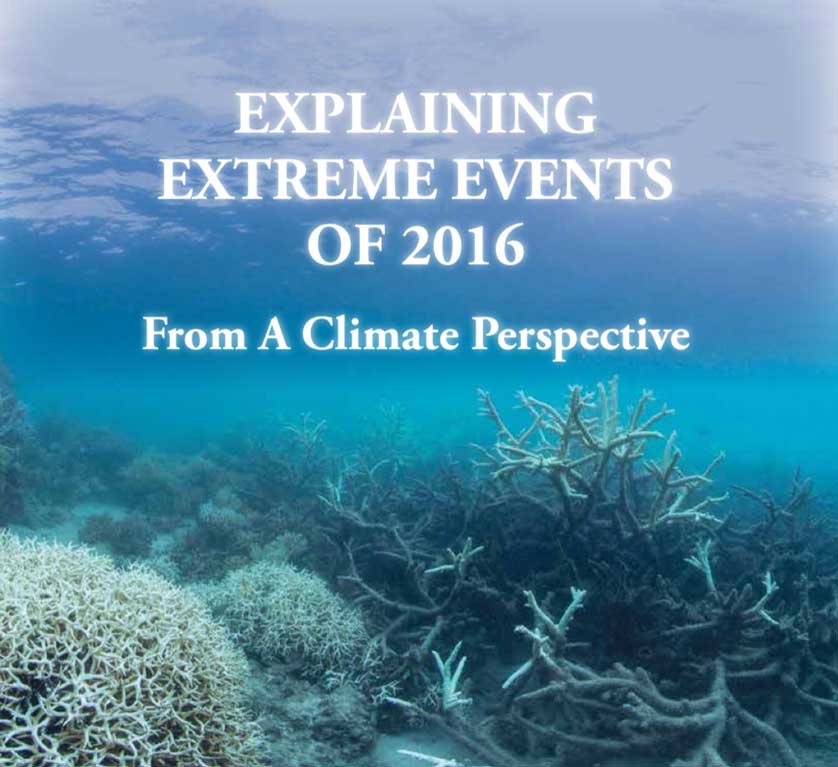 The American Meteorological Society has issued a report that very decisively and clearly points the finger at humans as the cause of extreme weather events. That is a first.
The American Meteorological Society has issued a report that very decisively and clearly points the finger at humans as the cause of extreme weather events. That is a first.
This latest version of the report examines 27 papers. Within the Abstract they clearly maintain their policy of having a neutral stance …
As in past years, the papers submitted to this report are selected prior to knowing the final results of whether human-caused climate change influenced the event. The editors have and will continue to support the publication of papers that find no role for human-caused climate change because of their scientific value in both assessing attribution methodologies and in enhancing our understanding of how climate change is, and is not, impacting extremes.
… and this is what actually happened …
In this report, twenty-one of the twenty-seven papers in this edition identified climate change as a significant driver of an event, while six did not. Of the 131 papers now examined in this report over the last six years, approximately 65% have identified a role for climate change, while about 35% have not found an appreciable effect.
This latest report is different
Within previous reports, the papers that did identify climate change as a factor simply pointed towards the shifting of the odds of the event happening.
This latest report changes that. It contains amongst the 27 papers, three that conclude that the extreme magnitude of a particular weather event was not possible without the influence of human-caused climate change.
This is significantly new.
Climate scientists have been predicting that, based on the ongoing global warming of Earth’s climate, the influence of human-caused climate change would at some point become sufficiently strong and emergent to push an extreme event beyond the bounds of natural variability alone – we have now reached that point.
It was also anticipated that we would likely first see this for heat events where the human-caused influences are most strongly observed – this also is exactly what has happened.
What exactly were these three papers?
Basically these three …
- In a paper analyzing the 2016 global heat record by NOAA scientist Tom Knutson et al., the authors concluded that record global warmth “was only possible due to substantial centennial- scale human-caused warming.”
- Similarly, a study of the record heat over Asia led by Yukiko Imada of the Japanese Meteorological Agency found that the extreme warmth across Asia in 2016 “would not have been possible without climate change.”
- In addition to these two papers looking at atmospheric temperatures, a team led by John Walsh of the University of Alaska determined that a large, persistent area of anomalously warm ocean water off the coast of Alaska (often referenced as “the Blob”) found “no instances of 2016-like anomalies in the preindustrial climate” for sea surface temperatures in the Bering Sea.
Is bias in play for paper selection?
In a word … no … and they explain exactly why this is the case …
papers are selected for consideration in this report by reviewing author proposals that do not indicate whether a role for climate change will or will not be found. Thus, there is no selection bias on the part of the editorial team toward one particular conclusion, and this publication prides itself as a venue that accepts papers without consideration for whether a role for climate change is found.
I’ll take that one step further. Because they are limiting the number of papers examining heat, and that is the area where we would expect to see a clear signal for human-caused events, then they are in all probability statistically biased against finding such a role for climate change.
One Further Thought
A very important stance taken is that no single weather event can ever be exclusively attributed to just climate change alone because natural variability also plays a role.
Does this latest report change that position?
The short answer is no.
The slightly longer answer is that while several of the studied events were found not to be possible without climate change, natural variability still laid the foundation for the events to occur. The authors do acknowledge this within their papers.
Extreme events are always the result of a cumulative set of factors. The building blocks that form the foundation of any event continue to include natural variability, with factors such as El Niño potentially adding to the strength of the event. These temperature-related extremes would likely still have been warm events even without human-caused climate change, but according to these analyses, the events could not have surpassed the extreme warm thresholds that they did without climate change. This was especially the case for the record-setting globally averaged temperature. At the global scale, the natural variations of Earth’s temperature are increasingly seen to pale in comparison to the growing intensity of human-induced warming. Overall, human-caused climate change allowed them to pass a threshold that they could not otherwise have exceeded.
